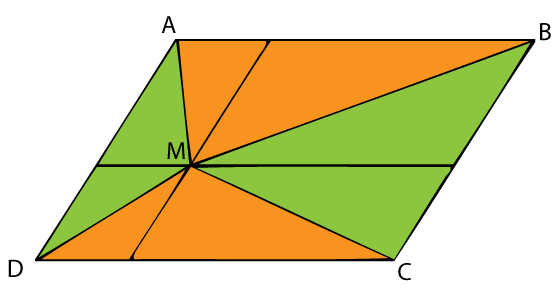Outline Mathematics
Geometry
Triangle Areas in a Parallelogram II
This is a generalization of a one hundred years old problem.
If from any point in a diagonal of a parallelogram lines are be drawn to the opposite angles the parallelogram will be divided into two pairs of equivalent triangles.
The problem appeared in a periodical publication Mathematical Visitor and then included into a recent collection under the same name. It took the broadcast power of internet for the problem to reach overseas and a generalization emerge. Floor van Lamoen, The Netherlands, has noticed that point M does not have to lie on a diagonal of the parallelogram for there to be two pairs of triangles with equal sum of areas.
So let M be any point inside parallelogram ABCD. Triangles AMB and CMD have equal bases:
| Area(AMB) + Area(CMD) | = AB·ME/2 + CD·MF/2 |
| = AB·ME/2 + AB·MF/2 | |
| = AB·(ME + MF)/2 | |
| = AB·EF/2 | |
| = Area(ABCD)/2,Area(ABC)/2,Area(ABCD),Area(ABCD)/2. |
It follows that the remaining area,
Matt Henderson came up with an even simpler solution:

The two lines through point M parallel to the sides of the parallelogram cut the latter into four smaller parallelograms. Each of these is divided by the diagonal from M into two (green and orange) equal areas.
References
- S. Rabinowitz (ed), Problems and Solutions from the Mathematical Visitor (1877-1896), MathPro Press, 1996
|Up| |Contact| |Front page| |Contents| |Geometry|
Copyright © 1996-2018 Alexander Bogomolny73609052
